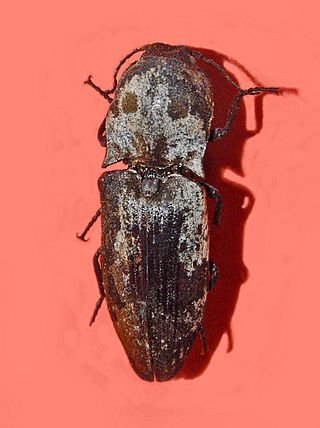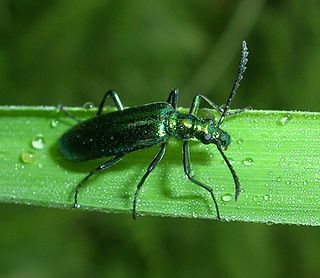
Flower chafers are a group of scarab beetles comprising the subfamily Cetoniinae. Many species are diurnal and visit flowers for pollen and nectar, or to browse on the petals. Some species also feed on fruit. The group is also called fruit and flower chafers, flower beetles and flower scarabs. There are around 4,000 species, many of them still undescribed.
Euryarthron is a genus in the beetle family Cicindelidae. There are more than 20 described species in Euryarthron, found in Africa.

Ceroplesis is a genus of flat-faced longhorn beetle in the subfamily Lamiinae of the family Cerambycidae.

Calais is a genus of click beetle belonging to the family Elateridae and the subfamily Agrypninae.

Artelida is a genus of beetles in the family Cerambycidae, containing the following species:

Logisticus is a genus of beetles in the family Cerambycidae, containing the following species:

Saperdini is a tribe of longhorn beetles of the subfamily Lamiinae.

Crossotini is a tribe of longhorn beetles of the subfamily Lamiinae. It was described by Thomson in 1864.
Diadelia is a genus of longhorn beetles of the subfamily Lamiinae, containing the following species:

Batrachorhina is a genus of longhorn beetles of the subfamily Lamiinae, containing the following species:

Ceroplesis aenescens is a species of beetle in the family Cerambycidae. It was described by Fairmaire in 1893. It is known from Ethiopia.
Ceroplesis aulica is a species of beetle in the family Cerambycidae. It was described by Pascoe in 1875. It is known from the Republic of Congo, the Democratic Republic of Congo, and Angola.

Ceroplesis calabarica is a species of beetle in the family Cerambycidae. It was described by Louis Alexandre Auguste Chevrolat in 1858. It is known from Angola, Benin, the Democratic Republic of the Congo, Cameroon, Gabon, Equatorial Guinea, Ghana, Mozambique, Nigeria, Kenya, the Republic of the Congo, Uganda, Togo, and Zambia. Its diet includes Coffea arabica and Coffea canephora.
Ceroplesis griseotincta is a species of beetle in the family Cerambycidae. It was described by Fairmaire in 1891. It is known from Tanzania and Kenya.

Ceroplesis orientalis is a species of beetle in the family Cerambycidae. It was described by Johann Friedrich Wilhelm Herbst in 1786. It is known from the Democratic Republic of the Congo, Angola, Cameroon, Malawi, Kenya, Gabon, Mozambique, Sierra Leone, Namibia, Somalia, Tanzania, South Africa, Zimbabwe, and Togo. It feeds on Acacia decurrens and Acacia abyssinica.

Ceroplesis poggei is a species of beetle in the family Cerambycidae. It was described by Harold in 1878. It is known from Angola, the Democratic Republic of the Congo, the Republic of the Congo, Mozambique, Uganda, Tanzania, Zimbabwe, and Zambia.

Ceroplesis quinquefasciata is a species of beetle in the family Cerambycidae. It was described by Johan Christian Fabricius in 1792. It is known from Angola, the Democratic Republic of the Congo, the Central African Republic, Cameroon, the Republic of the Congo, Equatorial Guinea, Ethiopia, Saudi Arabia, South Africa, Senegal, Togo, Tanzania, Zambia, and Uganda.
Ceroplesis semitrabeata is a species of beetle in the family Cerambycidae. It was described by Fairmaire in 1887. It is known from Malawi and Tanzania.
Cyrtonus is a genus of leaf beetles in the subfamily Chrysomelinae.

Idgia is a genus of beetles in the family Prionoceridae. They are distributed within the Old World tropics. These elongated beetles have soft elytra. Males have a comb on the inner edge of the distal tarsal segment of the foreleg.














